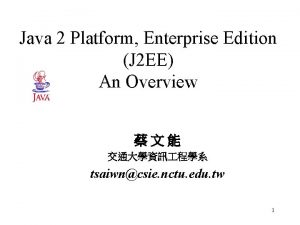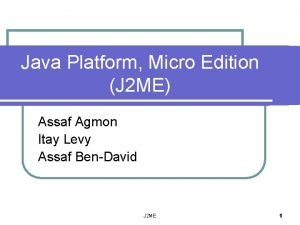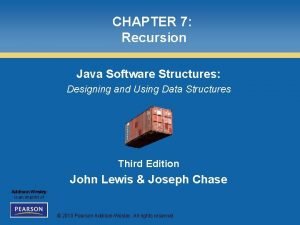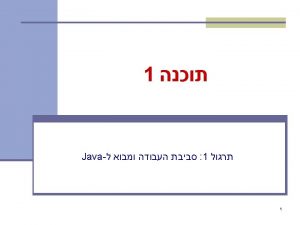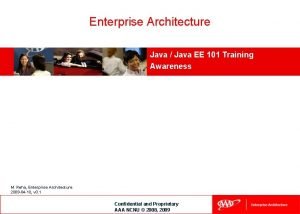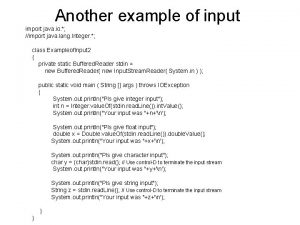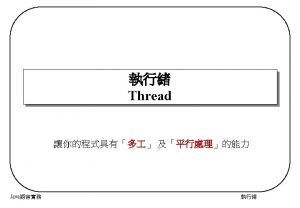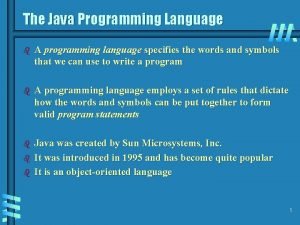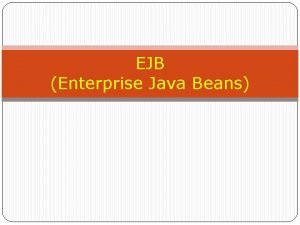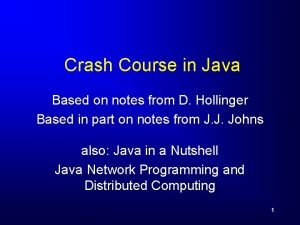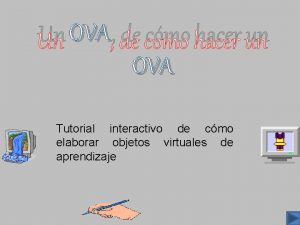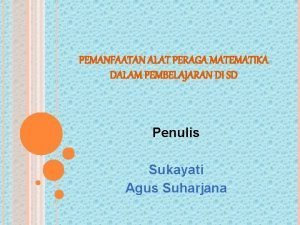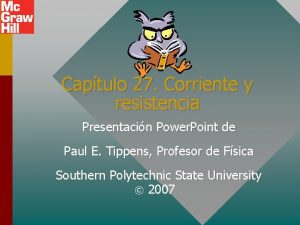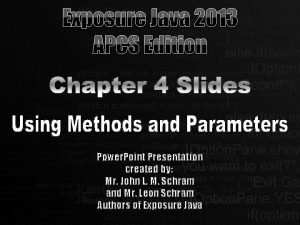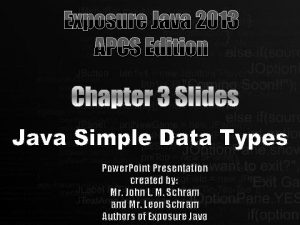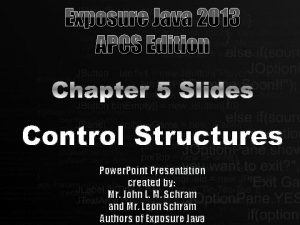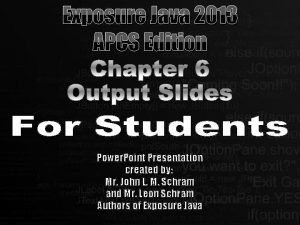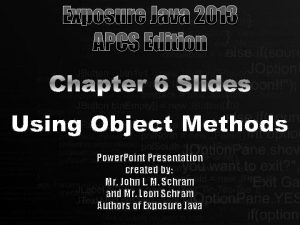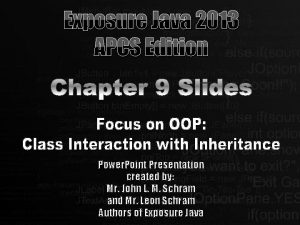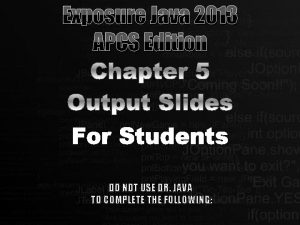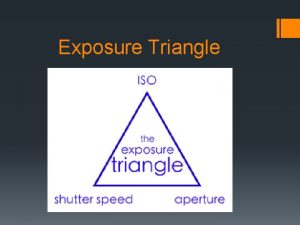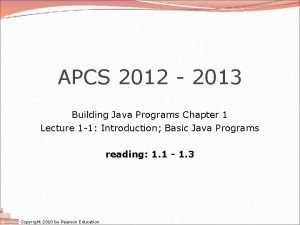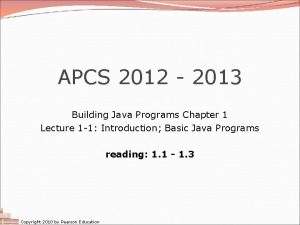Exposure Java 2013 APCS Edition Power Point Presentation








































































- Slides: 72

Exposure Java 2013 APCS Edition Power. Point Presentation created by: Mr. John L. M. Schram and Mr. Leon Schram Authors of Exposure Java

Section 7. 1

Primitive Data Types vs. Classes A simple/primitive data type can store only one single value. This means an int can only store one integer. A double can only store one real number. A char can only store one character. On the other hand, a class is a complex data type. An object is a complex variable that can store multiple pieces of information (class attributes) as well as several methods (class actions).

“Mr. Soto, are object methods ‘void’ or ‘return’ methods? ” What you need to realize is that the whole class method vs. object method thing has nothing to do with the whole void method vs. return method thing. Let us spell it out plainly: 1. A method can be BOTH a void method and a class method. 2. A method can be BOTH a void method an object method. 3. A method can be BOTH a return method and a class method. 4. A method can be BOTH a return method an

Section 7. 2

Additional Math Class Methods Math. exp(p) returns the antilog of p, or ep Math. log(p) returns the log (base e) of p Math. sin(p) returns the trigonometric sine of p Math. cos(p) returns the trigonometric cosine of p Math. tan(p) returns the trigonometric tangent of p Math. to. Degrees(p) returns the number of degrees in p radians Math. to. Radians(p) returns the number of radians in p degrees

// Java 0701. java // This program reviews using class methods and demonstrates most of the // available <Math> class methods and data fields. public class Java 0701 { public static void main (String args[]) { System. out. println("n. JAVA 0701. JAVAn"); System. out. println("The value of E is " + Math. E); System. out. println("The value of PI is " + Math. PI); System. out. println("The absolute value of (-25) is " + Math. abs(-25)); System. out. println("The square root of (1024) is " + Math. sqrt(1024)); System. out. println("The ceiling of (5. 00001) is " + Math. ceil(5. 00001)); System. out. println("The floor of (5. 99999) is " + Math. floor(5. 99999)); System. out. println("The round of (5. 50001) is " + Math. round(5. 50001)); System. out. println("The antilog of (4. 605170185) is "+ Math. exp(4. 605170185)); System. out. println("The log of (100) is " + Math. log(100)); System. out. println("The max of (1000, 999) is " + Math. max(1000, 999)); System. out. println("The min of (1000, 999) is " + Math. min(1000, 999)); System. out. println("The power of (4, 3) is " + Math. pow(4, 3)); System. out. println("The random of () is " + Math. random()); System. out. println("The sine of (0) is " + Math. sin(0)); System. out. println("The cosine of (3. 141592653) is "+ Math. cos(3. 141592653)); System. out. println("The tangent of (0. 785398163) is "+ Math. tan(0. 785398163)); System. out. println("The to. Degrees of (3. 141592653) is "+ Math. to. Degrees(3. 141592653));


Section 7. 3

Modular Programming is the process of placing statements that achieve a common purpose into its own module. An old programming says it well: One Task, One Module

// Java 0702. java // This program displays a simple mailing address. // It is used to demonstrate how to divide sections in // the main method into multiple user-created methods. public class Java 0702 { public static void main(String[] args) { System. out. println("n. JAVA 0702. JAVAn"); System. out. println("Kathy Smith"); System. out. println("7003 Orleans Court"); System. out. println("Kensington, Md. 20795"); System. out. println(); } }

// Java 0703. java // This program introduces user-created class methods. // The three class methods are called with the same dot. method syntax // as the methods of the Math class. public class Java 0703 { public static void main(String[] args) { System. out. println("n. JAVA 0703. JAVAn"); Java 0703. full. Name(); Java 0703. street(); Java 0703. city. State. Zip(); System. out. println(); } public static void full. Name() public static void street() Court"); } public static void city. State. Zip() { System. out. println("Kathy Smith"); } { System. out. println("7003 Orleans { System. out. println("Kensington, Md.

// Java 0704. java // This program example displays the same output as the previous program. // This time the methods are called directly without using the class identifier. // Omitting the class identifier is possible because all the methods are // encapsulated in the same class, Java 0704. public class Java 0704 { public static void main(String[] args) { System. out. println("n. JAVA 0704. JAVAn"); full. Name(); street(); city. State. Zip(); System. out. println(); } public static void full. Name() public static void street() Court"); } public static void city. State. Zip() { System. out. println("Kathy Smith"); } { System. out. println("7003 Orleans { System. out. println("Kensington, Md.

Using the Class Identifier The name of the class is called the class identifier. Using the class identifier is optional if you are calling a method that is in the same class. Using the class identifier is required if you are calling a method that is in a different class.

// Java 0705. java // This program demonstrates how to use a second class separate from the // main program class. This program will not compile because the Name, // Street and City. State. Zip methods are no longer encapsulated in Java 0705. public class Java 0705 { public static void main(String args[]) { System. out. println("n. JAVA 0705. JAVAn"); full. Name(); street(); city. State. Zip(); System. out. println(); } } class Address { public static void full. Name() public static void street() Court"); } public static void city. State. Zip() { System. out. println("Kathy Smith"); } { System. out. println("7003 Orleans { System. out. println("Kensington, Md.

// Java 0706. java // The problem of Java 0705. java is now fixed. It is possible to declare // multiple classes in one program. However, you must use the dot. method // syntax to call any of the <Address> class methods. public class Java 0706 { public static void main(String args[]) { System. out. println("n. JAVA 0706. JAVAn"); Address. full. Name(); Address. street(); Address. city. State. Zip(); System. out. println(); } } class Address { public static void full. Name() public static void street() Court"); } public static void city. State. Zip() { System. out. println("Kathy Smith"); } { System. out. println("7003 Orleans { System. out. println("Kensington, Md.

// Java 0706. java // The problem of Java 0705. java is now fixed. It is possible to declare // multiple classes in one program. However, you must use the dot. method // syntax to call any of the <Address> class methods. public class Java 0706 { public static void main(String args[]) { System. out. println("n. JAVA 0706. JAVAn"); Address. full. Name(); NOTE: Address. street(); Address. city. State. Zip(); The 2 nd class does NOT System. out. println(); use the keyword public. } Only the class with the same } class Address { public static void full. Name() public static void street() Court"); } public static void city. State. Zip() name as the file uses public. { System. out. println("Kathy Smith"); } { System. out. println("7003 Orleans { System. out. println("Kensington, Md.

// Java 0707. java // This program draws a house by placing all the necessary program statements in the <paint> method. import java. awt. *; import java. applet. *; public class Java 0707 extends Applet { public void paint(Graphics g) { NOTE: This is NOT Good Program Design. If you wanted to change the appearance of Expo. set. Color(g, Expo. blue); Expo. draw. Rectangle(g, 200, 500, 300); the door or a window, you would have to Expo. draw. Rectangle(g, 200, 300, 500, 400); Expo. set. Color(g, Expo. red); figure out which part of the program to edit. } } Expo. draw. Line(g, 200, 350, 100); Expo. draw. Line(g, 500, 200, 350, 100); Expo. draw. Line(g, 200, 500, 200); Expo. set. Color(g, Expo. red); Expo. draw. Line(g, 420, 146, 420, 80); Expo. draw. Line(g, 420, 80, 450, 80); Expo. draw. Line(g, 450, 80, 450, 166); Expo. set. Color(g, Expo. black); Expo. draw. Rectangle(g, 330, 340, 370, 400); Expo. draw. Oval(g, 350, 370, 10, 20); Expo. fill. Circle(g, 366, 370, 3); Expo. set. Color(g, Expo. black); Expo. draw. Rectangle(g, 220, 280); Expo. draw. Line(g, 220, 250, 280, 250); Expo. draw. Line(g, 250, 220, 250, 280); Expo. draw. Rectangle(g, 420, 220, 480, 280); Expo. draw. Line(g, 420, 250, 480, 250); Expo. draw. Line(g, 450, 220, 450, 280); Expo. draw. Rectangle(g, 320, 220, 380, 280); Expo. draw. Line(g, 320, 250, 380, 250); Expo. draw. Line(g, 350, 220, 350, 280); Expo. draw. Rectangle(g, 220, 320, 280, 380); Expo. draw. Line(g, 220, 350, 280, 350); Expo. draw. Line(g, 250, 320, 250, 380); Expo. draw. Rectangle(g, 420, 320, 480, 380); Expo. draw. Line(g, 420, 350, 480, 350); Expo. draw. Line(g, 450, 320, 450, 380);

// Java 0708. java // This program divides all the statements of <paint> in the previous program into 5 separate methods public static void draw. Chimney(Graphics g) import java. awt. *; { import java. applet. *; g. set. Color(Color. red); public class Java 0708 extends Applet g. draw. Line(420, 146, 420, 80); { g. draw. Line(420, 80, 450, 80); g. draw. Line(450, 80, 450, 166); public void paint(Graphics g) } { } draw. Floors(g); draw. Roof(g); draw. Chimney(g); draw. Door(g); draw. Windows(g); public static void draw. Door(Graphics g) { g. set. Color(Color. black); g. draw. Rect(330, 340, 60); g. draw. Oval(340, 350, 20, 40); g. fill. Oval(364, 370, 5, 5); } public static void draw. Floors(Graphics g) { g. set. Color(Color. blue); g. draw. Rect(200, 300, 100); } public static void draw. Roof(Graphics g) { g. set. Color(Color. red); g. draw. Line(200, 350, 100); g. draw. Line(500, 200, 350, 100); g. draw. Line(200, 500, 200); } } public static void draw. Windows(Graphics g) { g. set. Color(Color. black); g. draw. Rect(220, 60, 60); g. draw. Line(220, 250, 280, 250); g. draw. Line(250, 220, 250, 280); g. draw. Rect(420, 220, 60); g. draw. Line(420, 250, 480, 250); g. draw. Line(450, 220, 450, 280); g. draw. Rect(320, 220, 60); g. draw. Line(320, 250, 380, 250); g. draw. Line(350, 220, 350, 280); g. draw. Rect(220, 320, 60); g. draw. Line(220, 350, 280, 350); g. draw. Line(250, 320, 250, 380); g. draw. Rect(420, 320, 60); g. draw. Line(420, 350, 480, 350); g. draw. Line(450, 320, 450, 380); }

// Java 0709. java This program uses the better program design of creating a separate <House> class, // which contains the five methods to draw the complete hour program. import java. awt. *; public static void draw. Chimney(Graphics g) import java. applet. *; { g. set. Color(Color. red); public class Java 0709 extends Applet g. draw. Line(420, 146, 420, 80); { g. draw. Line(420, 80, 450, 80); public void paint(Graphics g) g. draw. Line(450, 80, 450, 166); { } House. draw. Floors(g); public static void draw. Door(Graphics g) House. draw. Roof(g); { House. draw. Chimney(g); g. set. Color(Color. black); House. draw. Door(g); g. draw. Rect(330, 340, 60); House. draw. Windows(g); g. draw. Oval(340, 350, 20, 40); } g. fill. Oval(364, 370, 5, 5); } } class House { public static void draw. Floors(Graphics g) { g. set. Color(Color. blue); g. draw. Rect(200, 300, 100); } public static void draw. Roof(Graphics g) { g. set. Color(Color. red); g. draw. Line(200, 350, 100); g. draw. Line(500, 200, 350, 100); g. draw. Line(200, 500, 200); } } public static void draw. Windows(Graphics g) { g. set. Color(Color. black); g. draw. Rect(220, 60, 60); g. draw. Line(220, 250, 280, 250); g. draw. Line(250, 220, 250, 280); g. draw. Rect(420, 220, 60); g. draw. Line(420, 250, 480, 250); g. draw. Line(450, 220, 450, 280); g. draw. Rect(320, 220, 60); g. draw. Line(320, 250, 380, 250); g. draw. Line(350, 220, 350, 280); g. draw. Rect(220, 320, 60); g. draw. Line(220, 350, 280, 350); g. draw. Line(250, 320, 250, 380); g. draw. Rect(420, 320, 60); g. draw. Line(420, 350, 480, 350); g. draw. Line(450, 320, 450, 380); }

Some Program Design Notes Programs should not be written by placing all the program statements in the main or paint methods. Program statements that perform a specific purpose should be placed inside their own modules. This follows the one-task, one-module principle of earlier program design principles. Object Oriented Design continues by placing modules of a common nature into a separate class. In this chapter you are learning how to create class methods. The distinction between creating class methods and object methods will become clear in the next chapter.

Section 7. 4

Method Calls With & Without Parameters Parameter method example: double result 1 = Math. sqrt(100); double result 2 = Math. pow(2, 5); Non-Parameter method examples: Bug barry = new Bug(); barry. move(); barry. turn(); Overloaded method examples: System. out. println("Hello World"); System. out. println();

// Java 0710. java // This program introduces user-defined methods with parameters. // The purpose of using parameters may be hard to tell, but at this // stage concentrate on the mechanics and the manner in which information // is passed from one program module to another program module. public class Java 0710 { public static void main(String args[]) { System. out. println("n. JAVA 0710. JAVAn"); display. Parameter(100); System. out. println(); } public static void display. Parameter(int number) { System. out. println(); System. out. println("The parameter value is " + number); System. out. println(); } }

Parameters Terminology Actual Parameters The parameters in the method call. This is the actual information that you are sending to the method. display. Parameter(100); Formal Parameters The parameters in the method heading. This is the formal declaration of the parameters. Here their form is determined. public static void display. Parameter(int number)

// Java 0711. java // This program demonstrates that the calling parameter can be: // a constant, like 100; a variable, like value; // an expression with only constants, like 10 + 5; // an expression with a variable and a constant like value + 5. // A call to a method, which returns a value, like Math. sqrt(100). public class Java 0711 { public static void main(String args[]) { System. out. println("n. JAVA 0711. JAVAn"); double value = 100; display. Parameter(100); display. Parameter(value); display. Parameter(100 + 5); display. Parameter(value + 5); display. Parameter(Math. sqrt(100)); System. out. println(); } public static void display. Parameter(double number) { System. out. println(); System. out. println("The parameter value is " + number); } }

// Java 0712. java // This program demonstrates passing two parameters to a method. // The <show. Area> method is called twice. In this case reversing // the sequence of the parameters is not a problem. public class Java 0712 { public static void main(String args[]) { System. out. println("n. JAVA 0712. JAVAn"); int width = 100; int height = 50; show. Area(width, height); show. Area(height, width); System. out. println(); } } public static void show. Area(int w, int h ) { System. out. println(); int area = w * h; System. out. println("The rectangle area is " + area); System. out. println(); }

The Football Analogy The Quarterback - The Actual Parameters show. Area(length, width); show. Area 100, 50 The Football - A copy of the data The actual parameters pass the data to the formal parameters. The Receiver - Formal Parameters public static void show. Area(int L, int W )

// Java 0713. java // This program demonstrates that parameter sequence matters. // In this example method <show. Difference> will display different // results when the calling parameters are reversed. public class Java 0713 { public static void main(String args[]) { System. out. println("n. JAVA 0713. JAVAn"); int num 1 = 100; int num 2 = 50; show. Difference(num 1, num 2); show. Difference(num 2, num 1); System. out. println(); } } public static void show. Difference(int a, int b) { System. out. println(); int difference = a - b; System. out. println("The difference is " + difference); System. out. println(); }

Actual Parameter Sequence Matters The first actual parameter passes information to the first formal parameter. The second actual parameter passes information to the second formal parameter. Parameters placed out of sequence may result in compile errors or logic errors.

// Java 0714. java // This program demonstrates a common mistake made by students. // Parameters are declared in the method heading, but may not be // declared in the method call. This program will not compile. public class Java 0714 { public static void main(String args[]) { System. out. println("n. JAVA 0714. JAVAn"); show. Difference(int num 1, int num 2); System. out. println(); } // line 1 public static void show. Difference(int a, b) // line 2 { System. out. println(); int difference = a - b; System. out. println("The difference is " + difference); System. out. println(); } }

Common Parameters Mistakes Wrong Correct qwerty(int num 1, int num 2); int num 1 = 100; int num 2 = 200; qwerty(num 1, num 2); public static void qwerty(int a, a, b); int b)

// Java 0715. java // This program demonstrates that multiple parameters may be different data types. public class Java 0715 { public static void main(String args[]) { System. out. println("n. JAVA 0715. JAVAn"); // 3 different type parameters method call multi. Type. Demo("Hans", 30, 3. 575); System. out. println(); } public static void multi. Type. Demo(String student. Name, int student. Age, double student. GPA) { System. out. println("n. This method has 3 parameters with three different types"); System. out. println("Name: " + student. Name); System. out. println("Age: " + student. Age); System. out. println("GPA: " + student. GPA); }

Parameter Rules The parameters in the method call and the method heading must match three ways: 1. They must be the same quantity 2. They must be the same type 3. They must be the same sequence

The Track Relay Analogy – Race 1 US GB FR NL US GB FR The second runner from the Netherlands is missing. The number of actual parameters and formal parameters do not match.

The Track Relay Analogy – Race 2 US GB FR NL US GB NL FR The second runners from the Netherlands and France are in the wrong lane. The formal parameters are not in the same order as the actual parameters. They must correspond.

The Track Relay Analogy – Race 3 US (John) GB (Charles) US (Greg) GB (William) FR (Gerald) FR (Louis) NL (Hans) The runners are in proper staring position. The parameters correspond. The fact that there are 2 people from the Netherlands with the same name is not a problem.

Important Rules About Using Parameters with Methods The number of parameters in the method call (actual parameters) must match the number of parameters in the method heading (formal parameters). The corresponding actual parameters must be the same type as the formal parameters. The sequence of the actual parameters must match the sequence of the formal parameters. The actual parameter identifiers may be the same identifier or a different identifier as the formal parameters.

Section 7. 5

// Java 0716. java This program demonstrates how to use the <Calc> class with void methods. public class Java 0716 { public static void main(String args[]) { System. out. println( "n. JAVA 0716. JAVAn"); int number 1 = 1000; int number 2 = 100; Calc. add(number 1, number 2); Calc. sub(number 1, number 2); Calc. mul(number 1, number 2); Calc. div(number 1, number 2); System. out. println(); } } class Calc { public static void add(int n 1, int n 2) { int result = n 1 + n 2; System. out. println(n 1 + " + n 2 + " = " + result); } public static void sub(int n 1, int n 2) { int result = n 1 - n 2; System. out. println(n 1 + " - " + n 2 + " = " + result); } public static void mul(int n 1, int n 2) { int result = n 1 * n 2; System. out. println(n 1 + " * " + n 2 + " = " + result); } public static void div(int n 1, int n 2) { int result = n 1 / n 2; System. out. println(n 1 + " / " + n 2 + " = " + result); } }

// Java 0717. java // This program demonstrates the difference between a // void <Sum 1> method and a return <Sum 2> method. // There are two differences: // void and return methods are declared differently. // void and return methods are also called differently. public class Java 0717 { public static void main(String args[]) { System. out. println("n. JAVA 0717. JAVAn"); int nbr 1 = 1000; int nbr 2 = 100; sum 1(nbr 1, nbr 2); System. out. println(nbr 1 + " + nbr 2 + " = " + sum 2(nbr 1, nbr 2)); System. out. println(); } public static void sum 1(int n 1, int n 2) { int sum = n 1 + n 2; System. out. println(n 1 + " + n 2 + " = " + sum); } } public static int sum 2(int n 1, int n 2) { int sum = n 1 + n 2; return sum; }

// Java 0718. java // This program reviews different ways to call a return method. public class Java 0718 { public static void main(String args[]) { System. out. println("n. JAVA 0718. JAVAn"); System. out. println("Sum: " + sum(200, 300)); int sum = sum(200, 300); System. out. println("Sum: " + sum); int checking = 200; int savings = 300; if (sum(checking, savings) <= 0) System. out. println("You are broke!"); else System. out. println("Let's go shopping!"); } } System. out. println(); public static int sum(int n 1, int n 2) { int sum = n 1 + n 2; return sum; }

// Java 0719. java // This program demonstrates how to create a four-function <Calc> class // with return methods. public class Java 0719 { public static void main(String args[]) { System. out. println("n. JAVA 0719 n"); int nbr 1 = 1000; int nbr 2 = 100; System. out. println(nbr 1 + " + nbr 2 + " = " + Calc. add(nbr 1, nbr 2)); System. out. println(nbr 1 + " - " + nbr 2 + " = " + Calc. sub(nbr 1, nbr 2)); System. out. println(nbr 1 + " * " + nbr 2 + " = " + Calc. mul(nbr 1, nbr 2)); System. out. println(nbr 1 + " / " + nbr 2 + " = " + Calc. div(nbr 1, nbr 2)); System. out. println(); } } class Calc { public static int add(int n 1, int n 2) { return n 1 + n 2; } public static int sub(int n 1, int n 2) { return n 1 - n 2; } public static int mul(int n 1, int n 2) { return n 1 * n 2; } public static int div(int n 1, int n 2) { return n 1 / n 2; } }

Section 7. 6

// Java 0720. java // This program demonstrates a user-declared <Util> with a variety of methods that can be used in any program. public class Java 0720 { public static void main(String args[]) { System. out. println("n. JAVA 0711 n"); Util. skip(2); System. out. println("This message is left justified"); Util. skip(2); Util. center("This message is centered"); Util. skip(2); Util. right. Justify("This message is right justified"); Util. skip(1); } } class Util { public static void skip(int n) { for (int k = 1; k <= n; k++) System. out. println(); } public static void center(String str) { int len = str. length(); int tab = (80 - len) / 2; for (int k = 1; k <= tab; k++) System. out. print(" "); System. out. println(str); } public static void right. Justify(String str) { int len = str. length(); int tab = 80 - len; for (int k = 1; k <= tab; k++) System. out. print(" "); System. out. println(str); } }

// Java 0721. java This program adds the <heading> method to the <Util> class. public class Java 0721 { public static void main(String args[]) { Util. heading("Leon Schram", "Java 0721. java", "10 -24 -06", "100 Points"); System. out. println("This message is left justified"); Util. skip(2); Util. center("This message is centered"); Util. skip(2); Util. right. Justify("This message is right justified"); Util. skip(1); } } class Util { public static void skip(int n) { for (int k = 1; k <= n; k++) System. out. println(); public static void center(String str) { int len = str. length(); int tab = (80 - len) / 2; for (int k = 1; k <= tab; k++) System. out. print(" "); System. out. println(str); } public static void right. Justify(String str) { int len = str. length(); int tab = 80 - len; for (int k = 1; k <= tab; k++) System. out. print(" "); System. out. println(str); } public static String spaces(int n) spaces is a { String temp = ""; for (int k = 1; k <= n; k++) temp += " "; return temp; helper method which is called by heading }

// Java 0721. java continued heading method of the Util class public static void heading(String name, String lab, String date, String points) { int name. Tab = 28 - name. length(); int lab. Tab = 28 - lab. length(); int date. Tab = 28 - date. length(); int points. Tab = 28 - points. length(); Util. skip(2); System. out. println("****************************************************"); System. out. println("** Student Name: " + name + spaces(name. Tab) + "**"); System. out. println("** Lab Assignment: spaces(lab. Tab) + "**"); System. out. println("** Date Due: spaces(date. Tab) + "**"); System. out. println("** Point Version: spaces(points. Tab) + "**"); " + lab + " + date + " + points +


// Java 0722. java // This program is identical to Java 0721. java with the <Util> class // not included in this file. public class Java 0722 { public static void main(String args[]) { Util. heading("Leon Schram", "Lab 0722", "10 -24 -06", "100 Points"); System. out. println("This message is left justified"); Util. skip(2); Util. center("This message is centered"); Util. skip(2); Util. right. Justify("This message is right justified"); Util. skip(1); } }

// Util. java // This file is the <Util> class. This file can compile by itself, but it cannot execute. // It requires the Java 0722. java driver program to test the <Util> class Util { public static void skip(int n) { for (int k = 1; k <= n; k++) System. out. println(); } public static void center(String str) { int len = str. length(); int tab = (80 - len) / 2; for (int k = 1; k <= tab; k++) System. out. print(" "); System. out. println(str); } public static void right. Justify(String str) { int len = str. length(); int tab = 80 - len; for (int k = 1; k <= tab; k++) System. out. print(" "); System. out. println(str); } public static String spaces(int n) { String temp = ""; for (int k = 1; k <= n; k++) temp += " "; return temp; } public static void heading(String name, String lab, String date, String points) { int name. Tab = 28 - name. length(); int lab. Tab = 28 - lab. length(); int date. Tab = 28 - date. length(); int points. Tab = 28 - points. length(); Util. skip(2); System. out. println("****************************************************"); System. out. println("** Student Name: " + name + spaces(name. Tab) + "**"); System. out. println("** Lab Assignment: " + lab + spaces(lab. Tab) + "**"); System. out. println("** Date Due: " + date + spaces(date. Tab) + "**"); System. out. println("** Point Version: " + points + spaces(points. Tab) + "**"); System. out. println("****************************************************"); Util. skip(2); } }

3 Steps of Java Compiling When the compiler encounters a statement like Util. skip(3) it needs to find the skip method in the Util class. It will look in 3 spaces: 1. It will look for a Util class in the file you are compiling. 2. It will look for a file called Util. class in the folder as the file you are compiling. It will look for a file called Util. java in that same folder, and then compile it into Util. class 3.

Section 7. 7

The Payroll Case Study You are about to study eight stages of a case study. This is the first of many case studies that will appear in your textbook. The first program will be very simplistic and each program will make some small change or add something new.

// Java 0723. java // Payroll Case Study #1 // The first stage of the Payroll program has correct syntax and logic. // However, there is no concern about any type of proper program design, // even to the degree that there is no program indentation. // This program is totally unreadable. import java. util. Scanner; import java. text. *; public class Java 0723 { public static void main (String args[]) { Scanner keyboard = new Scanner(System. in); String a; double b, c, e, f, g, h, i, j, k; int d; Decimal. Format output = new Decimal. Format("$0. 00"); System. out. println("n. PAYROLL CASE STUDY #1n"); System. out. print("Enter Name ===>> "); a = keyboard. next. Line(); System. out. print("Enter Hours Worked ===>> "); b = keyboard. next. Double(); System. out. print("Enter Hourly Rate ===>> "); c = keyboard. next. Double(); System. out. print ("Enter Dependents ===>> "); d = keyboard. next. Int(); if (b > 40) { e = b - 40; k = 40 * c; j = e * c * 1. 5; } else { k = b * c; j = 0; } g = k + j; switch (d) { case 0 : f = 0. 295; break; case 1 : f = 0. 249; break; case 2 : f = 0. 187; break; case 3 : f = 0. 155; break; case 4 : f = 0. 126; break; case 5 : f = 0. 100; break; default: f = 0. 075; } i = g * f; h = g - i; System. out. println("nn"); System. out. println("Name: " + a); System. out. println("Hourly rate: " + output. format(c)); System. out. println("Hours worked: " + b); System. out. println("Dependants: " + d); System. out. println("Tax rate: " + output. format(f)); System. out. println("Regular pay: " + output. format(k)); System. out. println("Overtime pay: " + output. format(j)); System. out. println("Gross pay: " + output. format(g)); System. out. println("Deductions: " + output. format(i)); System. out. println("Net pay: " + output. format(h)); System. out. println("nn"); } }


// Java 0724. java // Payroll Case Study #2 // The second stage does use indentation, but it is still very poor program design. // All the program logic is contained in the <main> method and there are no program // comments anywhere, nor are the identifiers self-commenting. import java. io. *; import java. text. *; public class Java 0724 { public static void main (String args[]) { Scanner keyboard = new Scanner(System. in); String a; double b, c, e, f, g, h, i, j, k; int d; Decimal. Format output = new Decimal. Format("$0. 00"); System. out. println("n. PAYROLL CASE STUDY #2n"); System. out. print("Enter Name ===>> "); a = keyboard. next. Line(); System. out. print("Enter Hours Worked ===>> "); b = keyboard. next. Double();

if (b > 40) { e = b - 40; k = 40 * c; j = e * c * 1. 5; } else { k = b * c; j = 0; } g = k + j; switch (d) { case 0 : f = 0. 295; break; case 1 : f = 0. 249; break; case 2 : f = 0. 187; break; case 3 : f = 0. 155; break; case 4 : f = 0. 126; break; case 5 : f = 0. 100; break; default: f = 0. 075; }

i = g * f; h = g - i; System. out. println("nn"); System. out. println("Name: " + a); System. out. println("Hourly rate: " + output. format(c)); System. out. println("Hours worked: " + b); System. out. println("Dependants: " + d); System. out. println("Tax rate: "+ output. format(f)); System. out. println("Regular pay: " + output. format(k)); System. out. println("Overtime pay: "+ output. format(j)); System. out. println("Gross pay: "+ output. format(g)); System. out. println("Deductions: " +

// Java 0725. java // Payroll Case Study #3 // Stage 3 improves program readability by using meaningful identifiers. import java. io. *; import java. text. *; public class Java 0725 { public static void main (String args[]) { Scanner keyboard = new Scanner(System. in); String employee. Name; double hours. Worked; double hourly. Rate; int num. Dependants; double overtime. Hours; double regular. Pay; double overtime. Pay; double tax. Rate; double gross. Pay; double tax. Deductions; double net. Pay; Decimal. Format output = new Decimal. Format("$0. 00");

System. out. println("n. PAYROLL CASE STUDY #3n"); System. out. print("Enter Name ===>> "); employee. Name = keyboard. next. Line(); System. out. print("Enter Hours Worked ===>> "); hours. Worked = keyboard. next. Double(); System. out. print("Enter Hourly Rate ===>> "); hourly. Rate = keyboard. next. Double(); System. out. print("Enter Deductions ===>> "); num. Dependants = keyboard. next. Int(); if (hours. Worked > 40) { overtime. Hours = hours. Worked - 40; regular. Pay = 40 * hourly. Rate; overtime. Pay = overtime. Hours * hourly. Rate * 1. 5; } else { regular. Pay = hours. Worked * hourly. Rate; overtime. Pay = 0; } gross. Pay = regular. Pay + overtime. Pay;

switch (num. Dependants) { case 0 : tax. Rate = 0. 295; break; case 1 : tax. Rate = 0. 249; break; case 2 : tax. Rate = 0. 187; break; case 3 : tax. Rate = 0. 155; break; case 4 : tax. Rate = 0. 126; break; case 5 : tax. Rate = 0. 100; break; default: tax. Rate = 0. 075; } tax. Deductions = gross. Pay * tax. Rate; net. Pay = gross. Pay - tax. Deductions; System. out. println("nn"); System. out. println("Name: System. out. println("Hourly rate: System. out. println("Hours worked: System. out. println("Dependants: System. out. println("Tax rate: System. out. println("Regular pay: System. out. println("Overtime pay: System. out. println("Gross pay: System. out. println("Deductions: System. out. println("Net pay: System. out. println("nn"); } } " + employee. Name); " + output. format(hourly. Rate)); " + hours. Worked); " + num. Dependants); " + output. format(tax. Rate)); " + output. format(regular. Pay)); " + output. format(overtime. Pay)); " + output. format(gross. Pay)); " + output. format(tax. Deductions)); " + output. format(net. Pay));

// Java 0726. java // Payroll Case Study #4 // Stage 4 separates the program statements in the main method with spaces and comments // to help identify the purpose for each segment. This helps program debugging and updating. // Note that this program does not prevents erroneous input. import java. io. *; import java. text. *; // provides access to input/output classes // used for text output with <Decimal. Format> class' public class Java 0726 { public static void main (String args[]) { /////////////////////////////////////////////////// // Program variables // String employee. Name; // employee name used on payroll check double hours. Worked; double hourly. Rate; int num. Dependants; // // // hours worked per week employee wage paid per hour number of dependants declared for tax double overtime. Hours; double regular. Pay; double overtime. Pay; // // // number of hours worked over 40 pay earned for up to 40 hours worked pay earned for hours worked above 40 rate purposes per week double tax. Rate; computation // tax rate, based on declared dependants, used for deduction

/////////////////////////////////////////////////// // Program objects // Scanner keyboard = new Scanner(System. in); // keyboard is used for interactive keyboard input Decimal. Format output = new Decimal. Format("$0. 00"); // output is used to display values in monetary format ////////////////////////////////////////////////// // Program input // System. out. println("n. PAYROLL CASE STUDY #3n"); System. out. print("Enter Name ===>> "); employee. Name = keyboard. next. Line(); System. out. print("Enter Hours Worked ===>> "); hours. Worked = keyboard. next. Double(); System. out. print("Enter Hourly Rate ===>> "); hourly. Rate = keyboard. next. Double(); System. out. print("Enter Dependants ===>> "); num. Dependants = keyboard. next. Int(); /////////////////////////////////////////////////

////////////////////////////////////////////// // Program computation // if (hours. Worked > 40) // qualifies for overtime pay { overtime. Hours = hours. Worked - 40; regular. Pay = 40 * hourly. Rate; overtime. Pay = overtime. Hours * hourly. Rate * 1. 5; } else // does not qualify for overtime pay { regular. Pay = hours. Worked * hourly. Rate; overtime. Pay = 0; }

switch (num. Dependants) // compute proper tax rate based on declared // dependants everybody gets 0. 075 tax // dependants are greater than 5 rate if { case 0 : tax. Rate = 0. 295; break; case 1 : tax. Rate = 0. 249; break; case 2 : tax. Rate = 0. 187; break; case 3 : tax. Rate = 0. 155; break; case 4 : tax. Rate = 0. 126; break; case 5 : tax. Rate = 0. 100; break; default: tax. Rate = 0. 075; } tax. Deductions = gross. Pay * tax. Rate; net. Pay = gross. Pay - tax. Deductions;

/////////////////////////////////////////////// // Output display, which simulates the printing of a payroll check // System. out. println("nn"); System. out. println("Name: "+ employee. Name); System. out. println("Hourly rate: output. format(hourly. Rate)); System. out. println("Hours worked: System. out. println("Dependants: System. out. println("Tax rate: output. format(tax. Rate)); System. out. println("Regular pay: output. format(regular. Pay)); System. out. println("Overtime pay: output. format(overtime. Pay)); System. out. println("Gross pay: output. format(gross. Pay)); System. out. println("Deductions: output. format(tax. Deductions)); System. out. println("Net pay: output. format(net. Pay)); "+ " + hours. Worked); " + num. Dependants); "+ "+ "+

Variable Terminology Local Variables Local variables are defined inside a method. They are only accessible inside that method. public static void compute. Grosspay() { double hours. Worked; double hourly. Rate; Class Variables Class variables are defined at the beginning of a class -outside of any method. They can be accessed by any method of that class. public class Java 0727 { static String employee. Name;

// Java 0727. java Payroll Case Study #5 // Stage #7 solves the problem of the previous program. The variables are declared in the <Java 0720> // class, which makes them available anywhere in the class. The previous program made variables only // available within their respective methods. Only some of the methods are shown on this slide. public class Java 0727 { static String employee. Name; static double hours. Worked; static double hourly. Rate; static int num. Dependants; static double overtime. Hours; static double regular. Pay; static double overtime. Pay; static double tax. Rate; static double gross. Pay; static double tax. Deductions; static double net. Pay; public static void main (String args[]) { System. out. println("n. PAYROLL CASE STUDY #5n"); enter. Data(); compute. Grosspay(); compute. Deductions(); compute. Netpay(); print. Check(); } public static void compute. Grosspay() { if (hours. Worked > 40) { overtime. Hours = hours. Worked - 40; regular. Pay = 40 * hourly. Rate; overtime. Pay = overtime. Hours * hourly. Rate * 1. 5; } else { regular. Pay = hours. Worked * hourly. Rate; overtime. Pay = 0; } gross. Pay = regular. Pay + overtime. Pay; } public static void compute. Netpay() { net. Pay = gross. Pay - tax. Deductions; }

// Java 0728. java // Payroll Case Study #6 // In Stage 8 the <main> method is part of the "driving" class, which is the class // responsible for the program execution sequence. The <main> method now // contains method calls to objects of the <Payroll> class. import java. io. *; import java. text. *; public class Java 0728 { public static void main (String args[]) { System. out. println("n. PAYROLL CASE STUDY #6n"); Payroll. enter. Data(); Payroll. compute. Grosspay(); Payroll. compute. Deductions(); Payroll. compute. Netpay(); Payroll. print. Check(); } }

class Payroll { // Only the enter. Data method is shown static String employee. Name; static double hours. Worked; static double hourly. Rate; static int num. Dependants; static double overtime. Hours; static double regular. Pay; static double overtime. Pay; static double tax. Rate; static double gross. Pay; static double tax. Deductions; static double net. Pay; public static void enter. Data() { Scanner keyboard = new Scanner(System. in); System. out. print("Enter Name ===>> "); employee. Name = keyboard. next. Line(); System. out. print("Enter Hours Worked ===>> "); hours. Worked = keyboard. next. Double(); System. out. print("Enter Hourly Rate ===>> "); hourly. Rate = keyboard. next. Double(); System. out. print("Enter Dependants ===>> "); num. Dependants = keyboard. next. Int(); }

Variable Terminology Variables that are declared inside a method or block are called local variables. Local variables are only accessible inside the method or block that they are defined in. Variables that are declared inside a class, but outside any method, are class variables. Class variables are accessible by any method of the class. Class variables are also called attributes. If a variable is only used by one method, it should be declared inside that method as a local variable. If a variable is used by 2 or more methods of a class, it should be declared as a class variable.

Program Design Notes This was the first introduction to program design. Additional design features will be introduced as you learn more objectoriented programming. At this stage you can already consider the following: • Program should use self-commenting identifiers. • Control structures and block structure need to use a consistent indentation style. • Specific tasks should be placed in modules called methods. • Similar methods accessing the same data should be placed in a class. • The main method should be used for program sequence, not large numbers of program statements.
 Apcsa recursion
Apcsa recursion Ap computer science a frq 2019
Ap computer science a frq 2019 Managing economic exposure and translation exposure
Managing economic exposure and translation exposure Operating exposure
Operating exposure Balance sheet hedge translation exposure
Balance sheet hedge translation exposure Managing economic exposure and translation exposure
Managing economic exposure and translation exposure Presentation topics for students in hindi
Presentation topics for students in hindi Power point presentation design west vancouver
Power point presentation design west vancouver Power trianlge
Power trianlge Powerbi in powerpoint
Powerbi in powerpoint Point point power
Point point power Mis chapter 6
Mis chapter 6 Using mis (10th edition)
Using mis (10th edition) Powerpivot 自習書
Powerpivot 自習書 Java 2 platform enterprise edition
Java 2 platform enterprise edition Java platform micro edition
Java platform micro edition Java software structures 4th edition
Java software structures 4th edition Java standard edition 8
Java standard edition 8 Java enterprise architecture
Java enterprise architecture Introduction to java programming 10th edition quizzes
Introduction to java programming 10th edition quizzes Advanced word power second edition answers
Advanced word power second edition answers Statistics: unlocking the power of data 1st edition
Statistics: unlocking the power of data 1st edition Science power 9 atlantic edition
Science power 9 atlantic edition Import java.util.scanner;
Import java.util.scanner; Java import java.util.*
Java import java.util.* Java applet swing
Java applet swing Import java.util.scanner
Import java.util.scanner Import java.io.*
Import java.io.* Gcd java
Gcd java Java util random
Java util random What is readline in java
What is readline in java Java import java.util.*
Java import java.util.* Java thread import
Java thread import Apa perbedaan antara java swing dengan java awt
Apa perbedaan antara java swing dengan java awt Import java.awt.event.*;
Import java.awt.event.*; Java interpreter
Java interpreter Java bean vs enterprise java bean
Java bean vs enterprise java bean Diameters of fetal head
Diameters of fetal head Leopold maneuver
Leopold maneuver Power tool safety powerpoint presentation
Power tool safety powerpoint presentation Java point
Java point Point of view presentation
Point of view presentation The starting point in a presentation
The starting point in a presentation Solar power satellites and microwave power transmission
Solar power satellites and microwave power transmission Potential power
Potential power Flex power power supply
Flex power power supply Unit of dispersive power
Unit of dispersive power Power of a power property
Power of a power property General power rule vs power rule
General power rule vs power rule Power angle curve in power system stability
Power angle curve in power system stability Power delivered vs power absorbed
Power delivered vs power absorbed Evangelio del domingo en power point
Evangelio del domingo en power point Aplausos sonido
Aplausos sonido La boutique del powerpoint
La boutique del powerpoint Tennis power point
Tennis power point Tm pp
Tm pp Power point sul riciclo in inglese
Power point sul riciclo in inglese Alat peraga geometri sma
Alat peraga geometri sma Sekolah sabat dewasa
Sekolah sabat dewasa Barni
Barni La boutique del power point
La boutique del power point La boutique del power point
La boutique del power point La boutique del powerpointx
La boutique del powerpointx Animasi terima kasih power point bergerak
Animasi terima kasih power point bergerak Decreto 1330 del 25 de julio de 2019
Decreto 1330 del 25 de julio de 2019 Conclusão apresentação power point
Conclusão apresentação power point Contenido de un portafolio
Contenido de un portafolio Cara mengoperasikan microsoft powerpoint
Cara mengoperasikan microsoft powerpoint Formula corriente
Formula corriente Advantages and disadvantages of powerpoint
Advantages and disadvantages of powerpoint Desventajas de power point
Desventajas de power point Come creare un power point per tesina
Come creare un power point per tesina La boutique del power point
La boutique del power point














